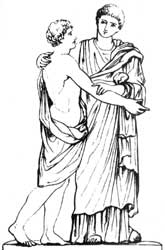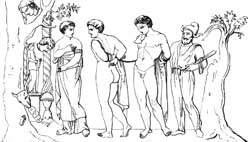Orestes
The only son of Agamemnon and Clytemnestra, and brother of Chrysothemis, Laodice (Electra), and Iphianassa (Iphigeneia).1
According to the Homeric account, Agamemnon his return from Troy did not see his son, but was murdered by Aegisthus and Clytemnestra before he had an opportunity of seeing him.2 In the eighth year after his father's murder Orestes came from Athens to Mycenae and slew the murderer of his father, and at the same time solemnized the burial of Aegisthus and of his mother, and for the revenge he had taken he gained great fame among mortals.3

This slender outline of the story of Orestes has been spun out and embellished in various ways by the tragic poets. Thus it is said that at the murder of Agamemnon it was intended also to despatch Orestes, but that Electra secretly entrusted him to the slave who had the management of him. This slave carried the boy to Strophius, king in Phocis, who was married to Anaxibia, the sister of Agamemnon. According to some, Orestes was saved by his nurse Geilissa4 or by Arsinoe or Laodameia,5 who allowed Aegisthus to kill her own child, thinking that it was Orestes. In the house of Strophius, Orestes grew up together with the king's son Pylades, with whom he formed that close and intimate friendship which has almost become proverbial.6
Being frequently reminded by messengers of Electra of the necessity of avenging his father's death, he consulted the Delphic oracle, which strengthened him in his plan. He therefore repaired in secret, and without being known to any one, to Argos.7 He pretended to be a messenger of Strophius, who had come to announce the death of Orestes, and brought the ashes of the deceased.8 After having visited his father's tomb, and sacrificed upon it a lock of his hair, he made himself known to his sister Electra, who was ill used by Aegisthus and Clytemnestra, and discussed his plan of revenge with her, which was speedily executed, for both Aegisthus and Clytemnestra were slain by his hand in the palace.9
Immediately after the murder of his mother he was seized by madness; he perceived the Erinyes of his mother and took to flight. Sophocles does not mention this as the immediate consequence of the deed, and the tragedy ends where Aegisthus is led to death; but, according to Euripides, Orestes not only becomes mad; but as the Argives, in their indignation, wanted to stone him and Electra to death, and as Menelaus refused to save them, Pylades and Orestes murdered Helen, and her body was removed by the gods.
Orestes also threatened Menelaus to kill his daughter Hermione; but by the intervention of Apollo, the dispute was allayed, and Orestes betrothed himself to Hermione, and Pylades to Electra. But, according to the common account, Orestes fled from land to land, pursued by the Erinyes of his mother. On the advice of Apollo, he took refuge with Athena at Athens. The goddess afforded him protection, and appointed the court of the Areopagus to decide his fate. The Erinyes brought forward their accusation, and Orestes made the command of the Delphic oracle his excuse. When the court voted, and was equally divided, Orestes was acquitted by the command of Athena.10 He therefore dedicated an altar to Athena Areia.11
According to another modification of the legend, Orestes consulted Apollo, how he could be delivered from his madness and incessant wandering. The god advised him to go to Tauris in Scythia, and thence to fetch the image of Artemis, which was12 believed to have there fallen from heaven, and to carry it to Athens.13 Orestes and Pylades accordingly went to Tauris, where Thoas was king, and on their arrival they were seized by the natives, in order to be sacrificed to Artemis, according to the custom of the country. But Iphigeneia, the priestess of Artemis, was the sister of Orestes, and, after having recognized each other, all three escaped with the statue of the goddess.14

After his return Orestes took possession of his father's kingdom at Mycenae, which had been usurped by Aletes or Menelaus; and when Cylarabes of Argos died without leaving any heir, Orestes also became king of Argos. The Lacedaemonians made him their king of their own accord, because they preferred him, the grandson of Tyndareus, to Nicostratus and Megapenthes, the sons of Menelaus by a slave. The Arcadians and Phocians increased his power by allying themselves with him.15 He married Hermione, the daughter of Menelaus, and became by her the father of Tisamenus.16 He is said to have led colonists from Sparta to Aeolis, and the town of Argos Orestieum in Epeirus is said to have been founded by him at the time when he wandered about in his madness.17
In his reign the Dorians under Hyllus are said to have invaded the Peloponnese.18 He died of the bite of a snake in Arcadia,19 and his body, in accordance with an oracle, was afterwards conveyed from Tegea to Sparta, and there buried.20 In a war between the Lacedaemonians and Tegeatans, a truce was concluded, and during this truce the Lacedaemonian Lichas found the remains of Orestes at Tegea or Thyrea in the house of a blacksmith, and thence took them to Sparta, which according to an oracle could not gain the victory unless it possessed the remains of Orestes.21
According to an Italian legend, Orestes brought the image of the Taurian Artemis to Aricia, whence it was carried in later times to Sparta; and Orestes himself was buried at Aricia, whence his remains were afterwards carried to Rome.22
❧
Iconography
Orestes is usually portrayed together with Pylades on vases, reliefs and sarcophagi. Particularly Roman frescoes depict scenes of Orestes' life, such as at the Casa di Olconio Rufo, Casa del Centenario, Casa di M. Lucrezio, and the Casa del Pinario Ceriale at Pompeii.
References
Notes
- Homer. Iliad ix, 142 ff., 284; comp. Sophocles. Electra, 154; Euripides. Orestes, 23.
- Odyssey xii, 542.
- Odyssey i, 30, 298; iii, 306 ff.; iv, 546.
- Aeschylus. Libation Bearers, 732.
- Pindar. Pythian Odes xii, 25, with the Scholiast.
- Euripides. Orestes, 804 ff.
- Sophocles. Electra, 11 ff., 35, 296, 531, 1346; Euripides. Electra, 1245; Orestes, 162.
- ibid., 1110.
- ibid., 1405; Aeschylus. Libation Bearers, 931; comp. Euripides. Electra, 625, 671, 774 ff., 969 ff., 1165 ff., who differs in several points from Sophocles.
- Aeschylus. Eumenides.
- Pausanias. Description of Greece i, 28.5.
- Euripides. Iphigeneia in Tauris, 79 ff., 968 ff.
- Comp. Pausanias. Description of Greece iii, 16.6.
- Euripides. Iphigeneia in Tauris, 800, 1327 ff.
- Pausanias. Description of Greece ii, 18.5; iii, 4; Philostratus. Heroicus, 6; Pindar. Pythian Odes xii, 24.
- Pausanias. Description of Greece ii, 18.5.
- Strabo. Geography vii, 326; xiii, 582; Pindar. Nemean Odes xii, 42, with the Scholiast.
- Pausanias. Description of Greece viii, 5.1.
- Scholiast on Euripides' Orestes, 1640.
- Pausanias. Description of Greece iii, 11.8.
- Herodotus. Histories i, 67 ff.; Pausanias. Description of Greece iii, 3.6; viii, 54.3.
- Servius on Virgil's Aeneid ii, 116.
Sources
- Aken, Dr. A.R.A. van. (1961). Elseviers Mythologische Encyclopedie. Amsterdam: Elsevier.
- Smith, William. (1870). Dictionary of Greek and Roman Biography and Mythology. London: Taylor, Walton, and Maberly.
This article incorporates text from Dictionary of Greek and Roman Biography and Mythology (1870) by William Smith, which is in the public domain.